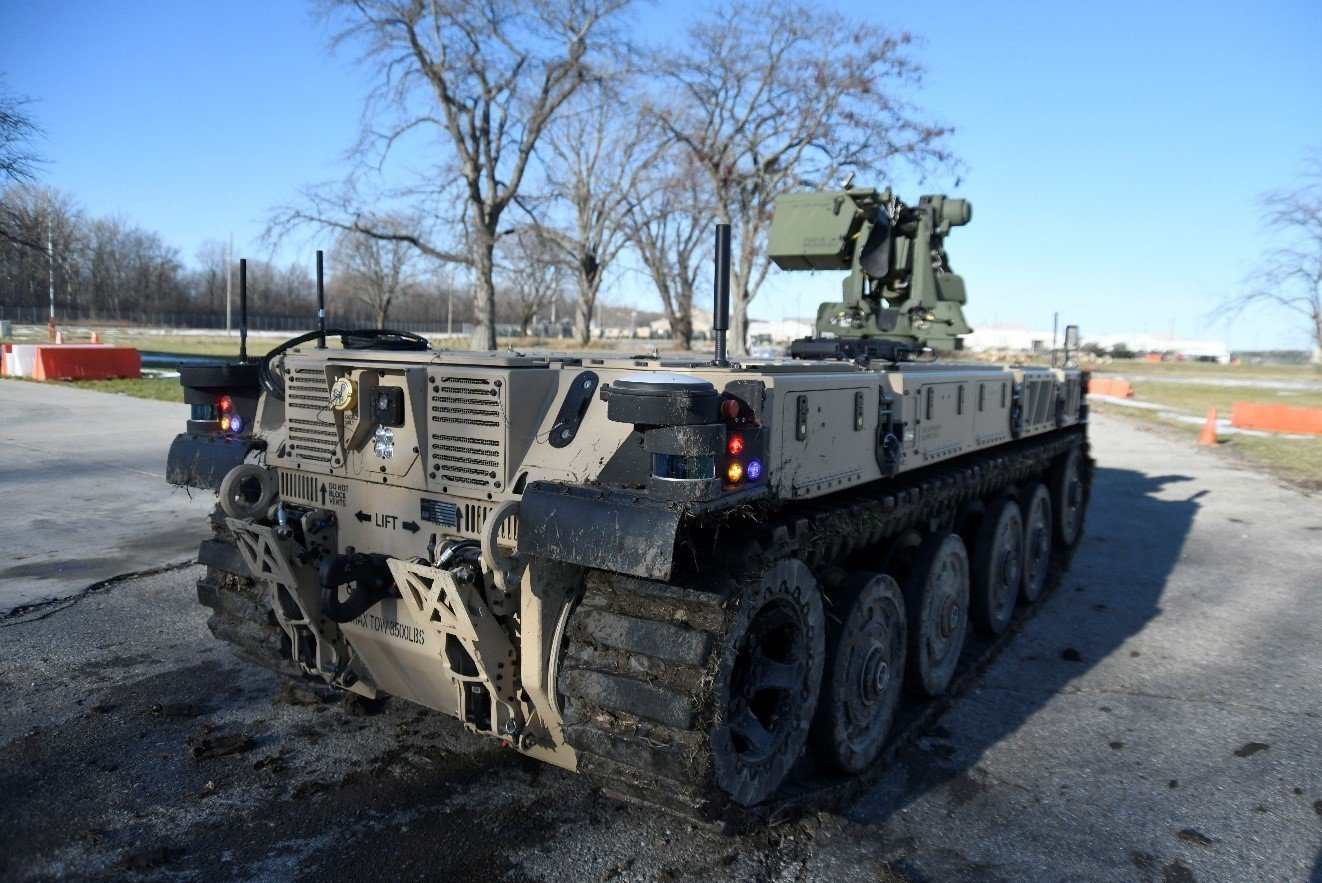The Michigan National Guard has announced that four Robotic Combat Vehicle – Light (RCV-L) experimental prototypes were delivered to Selfridge Air National Guard Base (SANGB), Michigan, where engineers from the U.S. Army Combat Capabilities Development Command’s began integrating software and hardware to conduct Manned/Unmanned –Teaming (MUM-T) testing.
According to a recent service news release, GVSC engineers will conduct maneuver testing on the RCV-L prototypes at Camp Grayling throughout 2021 to help determine the feasibility of integrating unmanned systems into ground combat vehicle formations.
Large-scale combat maneuver tests are routinely conducted at Camp Grayling, a 148,000-acre training area in northern Michigan with a variety of multi-use ranges and maneuver courses able to accommodate air-to-ground live fires, artillery, tanks, mortars and small arms.
– ADVERTISEMENT – CONTINUE READING BELOW –
“GVSC leverages the facilities at Camp Grayling, which provides the perfect location to test a wide range of robotic combat systems in different terrains,” said Kevin Mills, associate director for Ground Vehicle Robotics at GVSC. “Camp Grayling gives our engineers and industry partners numerous options to explore the full performance capabilities of next-generation unmanned ground systems in our own backyard. Grayling’s extremely challenging off-road terrain and vast secure live-fire test areas allow us to push experimental prototypes to their limits and safely evaluate weapons systems on combat robotics.”
Army Maj. Gen. Paul D. Rogers, adjutant general and Department of Military and Veterans Affairs director, said the relationship between the military and the defense industrial base in southeast Michigan dates back to World War II.
“These partnerships combined with the unique geography of northern Michigan and our high-tech infrastructure and expertise make Michigan an ideal proving ground for new technologies like the RCV-L prototype,” Rogers said.
At Northern Strike 20, the Michigan National Guard’s annual joint, reserve component readiness exercise held in Northern Michigan, U.S. and Latvian Joint Terminal Attack Controllers (JTAC) collaborated with industry to demonstrate a new Android Tactical Awareness Kit that uses cellular technology instead of Wi-Fi. According to Air Force Master Sgt. Patricia Boyer, a Michigan National Guard cyber operations specialist, the new technology significantly improved communications, data and video transmissions from above the battlefield, providing enhanced real-time situational awareness.
“We’re trying to build a mobile innovative capability to solve problems in real-time,” said Air Force Brig. Gen. Bryan Teff, assistant adjutant general for air and commander of the Michigan Air National Guard. “Our aim is to demonstrate this during Northern Strike 21 and future iterations of the exercise.”
The Michigan National Guard unveiled its National All-Domain Warfighting Center (NADWC) at Camp Grayling during Northern Strike 20 in July. The NADWC includes a 17,000-square-mile special-use airspace that extends over a portion of Lake Huron. This airspace is the nexus between the NADWC’s four supporting bases: Camp Grayling, the Alpena Combat Readiness Training Center, Battle Creek Air National Guard Base, and SANGB.
This support network allows the NADWC to offer unique all-domain training and testing not typically available at a single location in the Midwest. In addition to the robust ground combat capabilities at Camp Grayling, the NADWC leverages the support of these bases to offer air-to-sea live fires, littoral operations, bombers, fighters, refueling, cargo and unmanned systems, as well as cyber, surveillance, intelligence, reconnaissance, and Joint All-Domain Command and Control (JADC2) operations.
Evaluating lessons learned in Iraq and Afghanistan, the Department of Defense’s Long Range Research and Development Planning Program (LRRDPP) and the Army Science Board have determined that advanced autonomy-enabled technologies will play a significant role in keeping Soldiers safe, and that a mix of manned/unmanned vehicles could prove instrumental in winning future conflicts against peer and near-peer adversaries.
Leveraging lessons learned testing the Expeditionary Modular Autonomous Vehicles (EMAV) that Pratt & Miller built for the Marine Corps, the RCV-L experimental prototype is built to help the Army conduct live Soldier experimentation with unmanned combat vehicles to better define how MUM-T operation will shape future warfare. Its highly versatile common architecture and modular payload features offer a scalable continuum of capabilities that can be adapted to new threats well into the future.
The RCV-L prototype is compact and lightweight and can easily be transported by military aircraft to remote locations. Its hybrid/diesel generator powers high voltage batteries that provide silent watch and stealth-like capabilities. It features high-resolution cameras, sensors and navigation equipment, and its modular platform can accommodate up to 7,000 lbs.
It can be equipped with a Tethered Unmanned Aerial System, a small drone that can deploy to conduct aerial reconnaissance while the vehicle is at a safe distance. Other equipment to be tested on the RCV-L experimental prototype includes the M153 Common Remotely Operated Weapons Station II (CROWS II), the .50-caliber M2 machine gun, and the 40 mm MK19 Mod 3 automatic grenade launcher.
Laurent Lannibois, QinetiQ’s RCV program manager, said the vehicle can be remotely controlled by a human operator or can function semi-autonomously along known/programmed routes. The Army is improving the RCV-L’s semi-autonomous and unmanned/autonomous capabilities.
“We don’t know exactly what the future holds, but the Michigan National Guard is working closely with the research and development community to enable combat formations and unburden our Soldiers,” said Rogers.
Rogers said autonomy-enabled systems will augment warfighter capabilities and increase battlefield mobility and lethality by creating greater distances from danger, making supply distribution safer and more efficient, and providing the flexibility to adapt to tomorrow’s ever-changing and evolving threats.
“Nothing can replace the life of a Soldier,” said Rogers. “Autonomy-enabled systems will help make us more expeditionary, keep the warfighter safe, and make them more efficient.”







